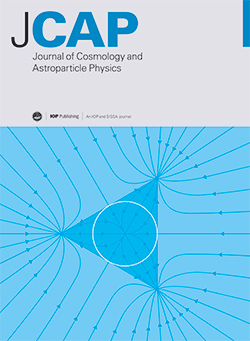Cherenkov Telescope Array Observatory sensitivity to heavy Galactic Cosmic Rays and the shape of particle spectrum
IF 5.3
2区 物理与天体物理
Q1 ASTRONOMY & ASTROPHYSICS
Journal of Cosmology and Astroparticle Physics
Pub Date : 2025-02-28
DOI:10.1088/1475-7516/2025/02/078
引用次数: 0
Abstract
The origin of Galactic Cosmic Rays (GCRs) and the potential role of Supernova Remnants (SNRs) as cosmic-ray (CR) accelerators remain subjects of ongoing debate. To shed more light on this topic, we have studied the spectral shapes of two SNRs, RX J1713.7-3946 and HAWC J2227+610, performing simulations for the Cherenkov Telescope Array Observatory (CTAO). The previous multi-wavelength (MWL) analysis on these two sources showed an important hadronic contribution at high energies. The interaction of the GCRs accelerated by the SNRs with the medium around the accelerator leads to a process of pion decay (PD) that produces gamma-rays (γ-rays). These emissions, detectable by CTAO, offer an indirect means of pinpointing the CR source. Two scenarios have been considered: the contribution of heavy CRs and different cut-off sharpnesses (β) of the particle spectra. The simulations were performed by using different CR composition distributions (protons, CNO, Fe) and different sharpness values ranging from β = 0.5 to β = 1.5. The results show that, in the cases studied here, CTAO will increase the sensitivity to the spectral shape of γ-rays. This allows us to distinguish protons from heavy CRs and obtain information on β values and therefore on different acceleration scenarios.银河宇宙射线(GCRs)的起源以及超新星残留物(SNRs)作为宇宙射线(CR)加速器的潜在作用仍然是争论不休的话题。为了进一步阐明这个问题,我们研究了两个超新星残留物--RX J1713.7-3946和HAWC J2227+610--的光谱形状,并为切伦科夫望远镜阵列天文台(CTAO)进行了模拟。之前对这两个来源进行的多波长(MWL)分析表明,在高能量下存在重要的强子贡献。SNR加速的GCR与加速器周围的介质相互作用,导致先驱衰变(PD)过程,产生伽马射线(γ射线)。CTAO 可以探测到这些辐射,为精确定位 CR 源提供了间接手段。我们考虑了两种情况:重 CR 的贡献和粒子光谱的不同截止锐度 (β)。模拟使用了不同的 CR 成分分布(质子、CNO、铁)和不同的锐度值(从 β = 0.5 到 β = 1.5)。结果表明,在本文研究的情况下,CTAO 会提高对 γ 射线光谱形状的灵敏度。这使我们能够区分质子和重 CR,并获得有关 β 值的信息,从而获得有关不同加速情况的信息。
本文章由计算机程序翻译,如有差异,请以英文原文为准。
求助全文
约1分钟内获得全文
求助全文
来源期刊

Journal of Cosmology and Astroparticle Physics
地学天文-天文与天体物理
CiteScore
10.20
自引率
23.40%
发文量
632
审稿时长
1 months
期刊介绍:
Journal of Cosmology and Astroparticle Physics (JCAP) encompasses theoretical, observational and experimental areas as well as computation and simulation. The journal covers the latest developments in the theory of all fundamental interactions and their cosmological implications (e.g. M-theory and cosmology, brane cosmology). JCAP''s coverage also includes topics such as formation, dynamics and clustering of galaxies, pre-galactic star formation, x-ray astronomy, radio astronomy, gravitational lensing, active galactic nuclei, intergalactic and interstellar matter.
 求助内容:
求助内容: 应助结果提醒方式:
应助结果提醒方式:


